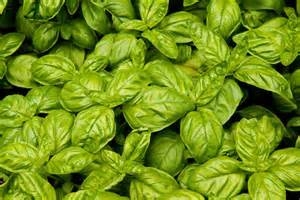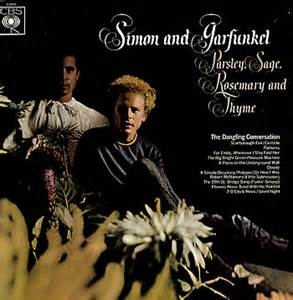
Many favorite herbs are perennial plants. I don't recommend growing these perennials in beds with annual vegetables, because the herbs need to stay in place for several seasons. Among the most common woody perennial herbs are rosemary, marjoram, oregano, sage and thyme. Plant them in a sunny location and don't over water. Trim them regularly to keep them shapely and you can enjoy them for several years. Rosemary plants can become quite large, so give them space or prune them vigorously from time to time.
Some herbs are invasive if not contained. Grow peppermint, spearmint, lemon balm and other mints in containers or in a part of your yard where they won't overtake other plants. These herbs thrive in partial shade in Napa Valley, and they like more water than the woody herbs. I have a happy patch of peppermint growing in a bed surrounded by a stone patio. It serves as a ground cover under a small citrus tree, and the water needs of both seem compatible.
One of my favorite garden herbs is French tarragon, but I learned the hard way that I shouldn't grow it in the vegetable patch. This plant dies back to its roots during cold weather. If grown in a spot that is undisturbed, it re-sprouts in the spring. I had a vigorous tarragon plant in the middle of a vegetable bed one summer. The next spring, before the tarragon sprouted, I cleared the bed of weeds and roots, accidentally including the dormant tarragon. My new tarragon planting is in a mostly ornamental bed close to the house. In the fall, I will mark its spot with a stake so that I don't uproot the plant by mistake.
In contrast, annual and biennial herbs make good neighbors for summer vegetables. Let's look at four of the common ones.
Basil is the queen of herbs in my summer garden. Traditional Italian types are essential for pesto, but there are dozens of other basils to try with different leaf color, leaf size and aroma. I like the purple varieties for their color, and I am also fond of lemon basil for a different but delicious pesto. Basils are frost sensitive, so plant them in late spring after the frost season ends. You can start basil easily from seed, or buy plants from the nursery. Remove flower spikes when they form, and the plants will produce leaves until cold weather kills them. If you have all the basil you need for cooking, you can let some of the plants bloom. The purple varieties, in particular, have pretty flowers.
Parsley is my old reliable. A biennial plant, it will go to seed during the winter, or sometimes at the end of summer. So I set out plants a couple of times during the year to have a fresh supply. There are two main types, curly-leafand flat-leaf, and both grow readily in ordinary garden soil.
You can start parsley from seed, but the seeds take a couple of weeks to sprout. If you don't have time for seed starting, buy a nursery six-pack, which produces plenty of parsley for family use. In my country garden, gophers are a problem, and they seem to like parsley roots. I plant parsley all around the vegetable patch, hoping that if gophers get one spot, they will miss the others and I will not lose my entire parsley crop.
Cilantro is a fast-growing herb essential to Mexican cuisine. It is easy to grow, but it does present one main problem. It grows so quickly from seed to bloom that you must plant it frequently to have a steady supply for the kitchen. It prefers cool weather, so in summer it will do better in a shady spot. Plants don't need much room, so try growing cilantro in the shade of larger summer plants such as tomatoes or pole beans. You can buy seedlings, but if you are a serious cilantro user, buy seeds and sow a few every couple of weeks.
Dill is another annual herb that merits more than one planting, particularly if you want to have dill for pickling in late summer. In my garden, I let some plants go to seed each summer. In April, the seeds will sprout and provide the first fresh leaves of the season. By June, this early dill will be sending up flower heads, so I plant a second crop toward the end of May. This system extends the harvest season and assures that I will have partially ripe heads for pickling when my cucumbers mature.
In summary, annual and biennial herbs can share the beds with vegetables, while perennial herbs need their own space. If you have no garden at all, consider containers. Many herbs do well in pots. Whether you choose to grow one or two or a few types, your summer meals will be much more flavorful.
Workshops: Napa County Master Gardeners will host a workshop on “Good Garden Resources in Print & Tech” on Saturday, July 11, from 9:30 a.m. to 11:30 a.m., at the University of California Cooperative Extension office, 1710 Soscol Avenue, Napa. Who do you trust for dependable gardening information? Where do you look for answers to your horticulture questions? Participants are invited to bring tablets or laptops. Master Gardeners will help you evaluate sources of gardening information, both online and in print.Online registration (credit card only);
Mail-in registration (cash or check only).
Napa County Master Gardener will also host a workshop on “Dealing with Drought and Drought-Tolerant Plants” on Saturday, July 11, from 10 a.m. to noon, at Mid-City Nursery, 3635 Broadway, American Canyon. Learn what to do now to help your garden survive on very little water. We will discuss what kinds of plants do best with minimal water. Learn about easy-care, long-flowering, colorful plants for your garden and ones that will attract pollinators. We will also discuss fire-wise plants and gardens. Online registration; Mail-in registration.
Master Gardeners are volunteers who help the University of California reach the gardening public with home gardening information. Napa County Master Gardeners ( http://ucanr.org/ucmgnapa/) are available to answer gardening questions in person or by phone, Monday, Wednesday and Friday, 9 a.m. to Noon, at the U. C. Cooperative Extension office, 1710 Soscol Avenue, Suite 4, Napa, 707-253-4143, or from outside City of Napa toll-free at 877-279-3065. Or e-mail your garden questions by following the guidelines on our web site. Click on Napa, then on Have Garden Questions? Find us on Facebook under UC Master Gardeners of Napa County.
Attached Images:
